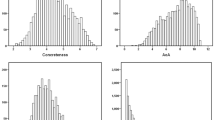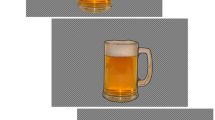Abstract
The oral stereognosis abilities of 40 young adults were investigated as a function of oral stereognosis form sets (four sets), retention time (unlimited and 5 sec), and response type (oral discrimination and visual recognition). Results showed that the Penn State forms were the easiest for the subjects under all conditions and that the Ringel form set was the most difficult under all conditions. A significant interaction between oral form sets and answer type indicated that the visual recognition task, rather than the discrimination task, was primarily responsible for the differences between the oral form sets. A three-way interaction revealed that the retention times had a significant effect on the two form sets of medium difficulty (NIDR-10 and NIDR-20) for the visual recognition condition. The results are discussed in view of their research and clinical implications.
Similar content being viewed by others
References
Arndt, W., Elbert, M., and Shelton, R. (1970). Standardization of a test of oral stereognosis. In Bosma, J. (ed.),Second Symposium on Oral Sensation and Perception, Thomas, Springfield, Ill.
Aungst, L. (1965). The relationship between oral stereognosis and articulation proficiency. Doctoral dissertation, Pennsylvania State University.
Bosma, J. (1967).Symposium on Oral Sensation and Perception, Thomas, Springfield, Ill.
Bosma, J. (1970).Second Symposium on Oral Sensation and Perception, Thomas, Springfield, Ill.
Class, L. (1956). A comparative study of normal speakers and speech defectives with regard to the tactual-kinesthetic perception of forms with the tongue. Master's thesis, Ohio State Univesity.
Edwards, A. (1964).Statistical Methods for the Behavioral Sciences, Holt, Rinchart. and Winston, New York.
Fucci, D., and Robertson, J. (1971). “Functional” defective articulation: An oral sensory disturbance.Percept. Mot. Skills 33: 711–714.
Hutchinson, J., and Bain, S. (1974). A comparison of two oral stereognosis testing strategies with children having articulation problems. Michigan State University.
Lass, N., and Clay, T. (1973). The effect of memory on subject performance on a test of oral form discrimination.West. Speech 37: 27–33.
Lass, N., Tekieli, M., and Eye, M. (1971). A comparative study of two procedures for assessment of oral tactile perception.Cent. States Speech J. 22: 21–26.
Lass, N., Bell, R., Simcoe, J., McClung, N., and Park, W. (1972). Assessment of oral tactile perception: Some methodological considerations.Cent. States Speech J. 3: 165–173.
Locke, J. (1969). Oral perception and articulation learning.Percept. Mot. Skills 26: 1259–1264.
Locke, J. (1969). Short-term auditory memory, oral perception, and experimental sound learning.J. Speech Hearing Res. 12: 185–192.
MacDonald, E., and Aungst, L. (1970). Apparent independence of oral sensory functions and articulatory proficiency. In Bosma, J. (ed.),Second Symposium on Oral Sensation and Perception, Thomas, Springfield, Ill.
Moser, H., LaGourgue, J., and Class, L. (1970). Studies of oral stereognosis in normal, blind, and deaf subjects. In Bosma, J. (ed.),Second Symposium on Oral Sensation and Perception, Thomas, Springfield, Ill.
Moser, H., LaGourgue, J., and Class, L. (1970). Studies of oral stereognosis in normal, blind, and deaf subjects. In Bosma, J. (ed.),Second Symposium on Oral Sensation and Perception, Thomas, Springfield, Ill.
Ringel, R. (1970a). Oral sensation and perception: A selective review.ASHA Reports, No. 5, pp. 188–206.
Ringel, R. (1970b). Studies of oral region texture perception. In Bosma, J. (ed.),Second Symposium on Oral Sensation and Perception, Thomas, Springfield, Ill.
Ringel, R., and Fletcher, H. (1967). Oral perception. III. Texture discrimination.J. Speech Hearing Res. 10: 642–649.
Ringel, R., Burk, K., and Scott, C. (1968). Tactile perception: Form discrimination in the mouth.Brit. J. Dis. Commun. 3: 150–155.
Ringel, R., Burk, K., and Scott, C. (1970a). Tactile perception: Form discrimination in the mouth. In Bosma, J. (ed.),Second Symposium on Oral Sensation and Perception, Thomas, Springfield, Ill.
Ringel, R., House, A., Burk, K., Dolinsky, J., and Scott, C. (1970b). Some relations between orosensory discrimination and articulatory aspects of speech production.J. Speech Hearing Dis. 35: 3–11.
Shelton, R. (1968). Oral sensory function in speech production. Prog. Report, NIDR (USPHS), Res. Career Develop. Award #DE 31, 669-01.
Solomon, B. (1965). The relation of oral sensation and perception to chewing, drinking, and articulation in athetoid children and adults. Doctoral dissertation, Pennsylvania State University.
Weinberg, B., Liss, G., and Hilis, J. (1970). A comparative study of visual, manual, and oral form identification in speech impaired and normal speaking children. In Bosma, J. (ed.),Second Symposium on Oral Sensation and Perception, Thomas, Springfield, Ill.
Winer, B. (1962).Statistical Principles in Experimental Design, McGraw-Hill, New York.
Author information
Authors and Affiliations
Rights and permissions
About this article
Cite this article
Torrans, A., Beasley, D.S. Oral stereognosis: Effect of varying form set, answer type, and retention time. J Psycholinguist Res 4, 159–167 (1975). https://doi.org/10.1007/BF01077035
Received:
Issue Date:
DOI: https://doi.org/10.1007/BF01077035




